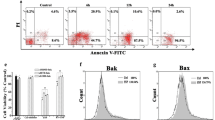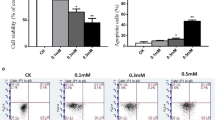Abstract
Backgrounds
Nitric oxide (NO) plays a key role in the pathological chondrocyte apoptosis of osteoarthritis (OA). Cytoskeletal proteins form cytoskeleton network to maintain normal chondrocyte structure and function. JNK and ERK pathways are the signal pathways involved in the cell apoptosis. The role of cytoskeletal proteins in cytoskeleton perturbation and cell apoptosis was investigated in this study.
Objectives
In vitro cell apoptosis was induced in rabbit articular chondrocytes by NO donor Sodium Nitroprusside (SNP). The JNK-specific inhibitor SP600125 and ERK-specific inhibitor PD98059 were employed to clarify the mechanism. The level of apoptosis was evaluated by TUNEL assay and Annexin V flow cytometry.
Results
SNP induced concentration-dependent apoptosis, which was further enhanced by PD98059 but reduced by SP600125. Furthermore, PD98059 significantly increased caspase-3 expression and activity respectively, whereas SP600125 reduced caspase-3 expression and activity. SP600125 increased the cytoskeletal protein mRNA and protein expression, while PD98059 decreased them.
Conclusion
Intracellular JNK/ERK pathways were involved in chondrocyte apoptosis induced by SNP through oppositely regulated effects on cytoskeletal proteins; ERK pathway protected cytoskeletal protein from dissolution via inhibition of caspase-3 activation, while JNK pathway promoted the dissolution via activation of caspase-3 activity.





Similar content being viewed by others
Data availability
Not applicable.
Change history
03 August 2022
A Correction to this paper has been published: https://doi.org/10.1007/s13273-022-00282-6
References
An S, Hu H, Li Y, Hu Y (2020) Pyroptosis plays a role in osteoarthritis. Aging Dis 11:1146–1156
Batshon G et al (2020) Serum NT/CT SIRT1 ratio reflects early osteoarthritis and chondrosenescence. Ann Rheum Dis 79:1370–1380
Chan K, Kwok CS, Sze ET, Lee FW (2018) Evaluation of the use of TRIzol-Based protein extraction approach for Gel-Based proteomic analysis of dried seafood products and Chinese tonic foods. Int J Mol Sci 19:1998
Cherng YG et al (2008) Apoptotic insults to human chondrocytes induced by sodium nitroprusside are involved in sequential events, including cytoskeletal remodeling, phosphorylation of mitogen-activated protein kinase kinase kinase-1/c-Jun N-terminal kinase, and Bax-mitochondria-mediated caspase activation. J Orthop Res 26:1018–1026
Fhied C, Kanangat S, Borgia JA (2014) Development of a bead-based immunoassay to routinely measure vimentin autoantibodies in the clinical setting. J Immunol Methods 407:9–14
Gregory KJ et al (2020) The use of patient-derived breast tissue explants to study macrophage polarization and the effects of environmental chemical exposure. Immunol Cell Biol 98:883–896
He B et al (2016) Carboxymethylated chitosan protects rat chondrocytes from NO-induced apoptosis via inhibition of the p38/MAPK signaling pathway. Mol Med Rep 13:2151–2158
He Z et al (2020) Irisin inhibits osteocyte apoptosis by activating the Erk signaling pathway in vitro and attenuates ALCT-induced osteoarthritis in mice. Bone 141:115573
Huang Y, Lu X, Ma J (2014) Toxicity of silver nanoparticles to human dermal fibroblasts on MicroRNA level. J Biomed Nanotechnol 10:3304–3317
Jiang L et al (2020) Nesfatin-1 suppresses interleukin-1 beta-induced inflammation, apoptosis, and cartilage matrix destruction in chondrocytes and ameliorates osteoarthritis in rats. Aging-Us 12:1741–1758
Jin P et al (2017) Nitric oxide nanosensors for predicting the development of osteoarthritis in rat model. Acs Appl Mater Inter 9:25128–25137
Kao XB et al (2018) SP600125 blocks the proteolysis of cytoskeletal proteins in apoptosis induced by gas signaling molecule (NO) via decreasing the activation of caspase-3 in rabbit chondrocytes. Eur J Pharmacol 824:40–47
Kim KW (2019) Prokaryotic cytoskeletons: In situ and ex situ structures and cellular locations. Anton Leeuw Int J G 112:145–157
Mobasheri A et al (2019) The chondrocyte channelome: a narrative review. Joint Bone Spine 86:29–35
Pascarelli NA et al (2015) Changes in ultrastructure and cytoskeletal aspects of human normal and osteoarthritic chondrocytes exposed to interleukin-1 beta and cyclical hydrostatic pressure. Int J Mol Sci 16:26019–26034
Sakhenberg EI, Nikolaenko NS, Pinaev GP (2014) Actin cytoskeleton organization and spreading of bone marrow stromal cells and cartilage cells during their combined and independent cultivation on different extracellular matrix proteins. Tsitologiia 56:708–716
Wu Y et al (2018) Effects of microRNA-24 targeting C-myc on apoptosis, proliferation, and cytokine expressions in chondrocytes of rats with osteoarthritis via MAPK signaling pathway. J Cell Biochem 119:7944–7958
Xu C et al (2020) FSTL1 promotes nitric oxide-induced chondrocyte apoptosis via activating the SAPK/JNK/caspase3 signaling pathway. Gene 732:144339
Yan Z et al (2020) The protective effect of myricitrin in osteoarthritis: an in vitro and in vivo study. Int Immunopharmacol 84:106511
Yu S, Yeo HJ, Choi SY, Kim SJ (2016) Cytokine-induced apoptosis inhibitor-1 causes dedifferentiation of rabbit articular chondrocytes via the ERK-1/2 and p38 kinase pathways. Int J Biochem Cell B 80:10–18
Zhang S et al (2019) MSC exosomes alleviate temporomandibular joint osteoarthritis by attenuating inflammation and restoring matrix homeostasis. Biomaterials 200:35–47
Zhou Y et al (2015) Berberine prevents nitric oxide-induced rat chondrocyte apoptosis and cartilage degeneration in a rat osteoarthritis model via AMPK and p38 MAPK signaling. Apoptosis 20:1187–1199
Zhou Y et al (2019) Ligustilide attenuates nitric oxide-induced apoptosis in rat chondrocytes and cartilage degradation via inhibiting JNK and p38 MAPK pathways. J Cell Mol Med 23:3357–3368
Acknowledgements
This work was funded by National Natural Science Foundation of China (No. 81673115 and 82073496), Huimin project of Ministry of science and technology of China (grant number 2012GS610101), Department of Health of Shaanxi Province (Project number: 2018D050), and International Cooperation Foundation of Shaanxi province (2020KW-057). CC was supported by Australian NHMRC and The University of Queensland.
Author information
Authors and Affiliations
Contributions
Chen Qun: conceptualization, validation, investigation, data curation, writing—original draft, funding acquisition. Kao Xibin: methodology, formal analysis, data curation, validation. Gao Yan: methodology, validation. Chen Jinghong: supervision. Dong Zhaoheng: project administration. Chen Chen: result interpretation & discussion, report writing, reviewing & editing.
Corresponding author
Ethics declarations
Conflict of interest
Qun Chen declares that she has no conflict of interest. Xibin Kao declares that he has no conflict of interest. Yan Gao declares that she has no conflict of interest. Jinghong Chen declares that she has no conflict of interest. Zhaoheng Dong declares that he has no conflict of interest. Chen Chen declares that he has no conflict of interest.
Ethical approval
This research was approved by the Ethics Committee of Xi'an Jiaotong University Health Science Center (License number 2011058).
Consent to participate
Not applicable.
Consent for publication
Not applicable.
Additional information
Publisher's Note
Springer Nature remains neutral with regard to jurisdictional claims in published maps and institutional affiliations.
The original online version of this article was revised: In this article Fig. 5 has been updated.
Rights and permissions
Springer Nature or its licensor holds exclusive rights to this article under a publishing agreement with the author(s) or other rightsholder(s); author self-archiving of the accepted manuscript version of this article is solely governed by the terms of such publishing agreement and applicable law.
About this article
Cite this article
Chen, Q., Kao, X., Gao, Y. et al. Nitric oxide-caused rabbit chondrocyte apoptosis is linked to cytoskeletal protein proteolysis anomaly through intracellular JNK and ERK signal pathways. Mol. Cell. Toxicol. 19, 71–79 (2023). https://doi.org/10.1007/s13273-022-00241-1
Accepted:
Published:
Issue Date:
DOI: https://doi.org/10.1007/s13273-022-00241-1




